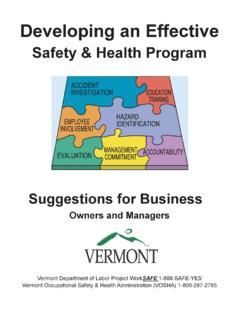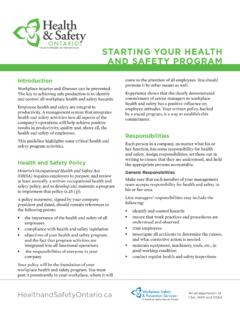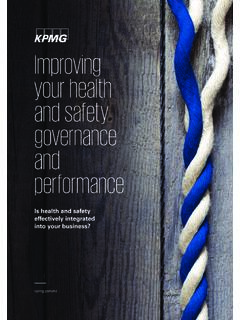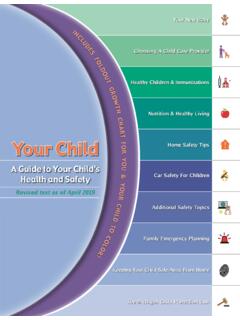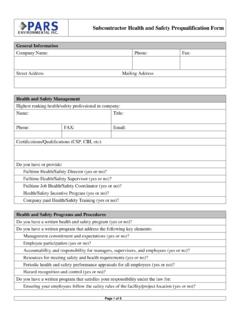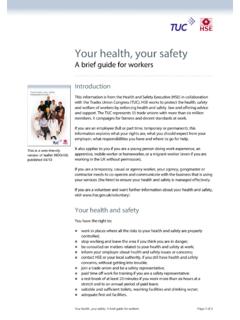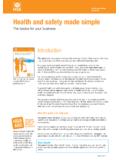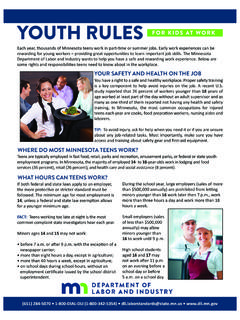Transcription of Understanding your Health and Safety responsibilities ...
1 Understanding your Health and Safety responsibilities under the new ActA guide for vehicle fleet operatorsJune | VEHICLE FLEET OPERATORS GUIDE | KPMG New Zealand s road Safety affects us all. Each year, approximately 330 people die and 12,100 people are injured as a result of motor vehicle related accidents. Despite substantial progress, New Zealand still lags behind many developed countries in road Safety performance. Every company uses vehicles some more than use of fleet vehicles in New Zealand has increased by 40% since 2000 (Source: Annual fleet statistics 2014).
2 The relaxed use of personal vehicles for work purposes (known as the grey fleet), is also increasing in New the introduction of the Health and Safety at Work Act 2015 (HSWA), the Government has set the ambitious target of reducing all workplace fatalities and serious incidents by at least 25% by new emphasis on safetyUnder the new Health and Safety at Work Act, vehicles are expressly included as a workplace . It is clear that organisations of all sizes need to look seriously at their responsibilities around vehicle and fleet Safety , and gain an Understanding of the risks associated with work that is completed partly or wholly in a new Act came into force on April 4, 2016.
3 If your organisation operates a vehicle fleet or your workers drive a grey fleet you need to consider how the Act will impact are some recent examples from New Zealand, where employers have got it wrong:In 2014, a company was fined $139,040for a faulty handbrake resulting in 2014, a company was fined$99,000for failure to maintain a vehicle s brake resulting in 2015, a company was fined$65,000for inadequate reversing system causing severe injury.(Source: WorkSafe NZ)In 2015, a company was fined $128,000for failing to ensure worker adequately trained to drive (forklift)
4 Causing 2016, a company was fined$151,000for not managing the lifting mechanism of a truck causing 2016, a company was fined$102,300for an inadequately secured truck hoist causing severe fines were under the old Health and Safety in Employment Act 1992, and are very likely to increase substantially under first step in shaping your response is to understand the new legislative | VEHICLE FLEET OPERATORS GUIDE | 3 HSWA, and its supporting regulations, represents the most significant change in the regulatory framework for Health and Safety in New Zealand for over 24 s more, there is now a dedicated entity, WorkSafe NZ that is responsible for proactively regulating Health and Safety in the workplace, and enforcing Health and Safety law.
5 Here are some of the key changes:Step 1: Understanding the key changes under the new Act (HSWA)HSWA brings increased duties for everyone: Person Conducting Business or Undertaking ( PCBU ) a PCBU has replaced the term employer . PCBUs can range from a large organisation through to self-employed people with their own company. Officers those in very senior roles serving a PCBU. This includes Board members, the Chief Executive Officer, and potentially other senior members of a PCBU such as the Chief Operating Officer and Chief Financial Officer.
6 Workers Anyone completing work for a PCBU ( employees, contractors and subcontractors).Importantly, duties for PCBUs, officers and workers are all personal. Duties cannot be transferred, and they cannot be | VEHICLE FLEET OPERATORS GUIDE | KPMG HSWA brings tougher penalties for everyone:RoleUninsurable costsCriminal RecordPCBU$3M max. fineApplicableOfficers$600K max. fineApplicable Workers$300K max. fineApplicableHealth & Safety in Employment Act 1992:RoleUninsurable costsCriminal RecordEmployer$500k maxNot applicableHSWA defines a vehicle as a workplace:A workplace now explicitly includes places where a worker goes, or is likely to be, while at work.
7 The wording of the new Act expressly includes responsibility for contracting owner/drivers: The definition of a worker under the Act now extends to include contractors and subcontractors in the if your organisation (PCBU) contracts work to a third party driver or company, you are now responsible for the Health and Safety of those workers (to the extent you can influence or control the situation and risks).HSWA sets an obligation for PCBUs, Officers and Workers to make the workplace risk free as far as is reasonably | VEHICLE FLEET OPERATORS GUIDE | 52.
8 Assess the hazard and its Implement suitable controls that eliminate or minimise Review and monitor effectiveness of Identify 2:Understand how to manage Health and Safety risksUnder HSWA, your organisation, as a PCBU, has an obligation to:6 | VEHICLE FLEET OPERATORS GUIDE | KPMG HSWA, and its supporting General Workplace Risk and Workplace Management Regulations identified a hierarchy of controls that should be used to manage risks. Organisations should maximise the use of the highest levels of control ( elimination and minimisation).
9 Hierarchy of Controls:Elimination The hazard is eliminated to avoid the riskMinimisation through:Isolation Preventing contactSubstitution The activity, process and/or material is substituted for one less hazardousEngineering The hazard is controlled through automated processes or physical enclosures (guarding)Administration The hazard is controlled through management strategies, procedures, training and signagePPE The hazard is controlled through the use of Personal Protective Equipment (PPE)WHAT KIND OF CONTROLS ARE NEEDED?
10 What level of control is needed?HSWA states you must do what is reasonably practicable to manage the risk. The cost of a control cannot be used a reason for not implementing that control (unless the cost is grossly disproportionate to the level of risk). Using a risk-based approach to assess the level of risk (likelihood and consequence) provides the basis for determining what level of control is needed. If the likelihood and/or impact of a risk occurring is high then a combination of controls may be needed.
